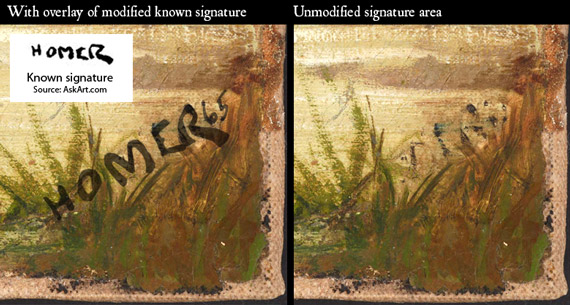Manner & Technique: Signature Area

Signature Area
The signature area, lower right, has been severely cleaned in an older restoration of the work which has removed much of the paint of the letters and date. What readily appears to the unaided eye are the remains of the letters ŌĆś..MERŌĆÖ, and partial paint pigments suggesting the date of either ŌĆś63ŌĆÖ or ŌĆś65ŌĆÖ. With a bit of study one can imagine that the signature is ŌĆśHOMER 65ŌĆÖ or possibly ŌĆś63ŌĆÖ, the all capital letters conforming to the signature used by Homer at that time period.
 Fig. 3-10: The signature area of Watching the Shot (lower right corner). The image on the right shows the unmodified signature area. The image on the left shows the area with a known signature overlaid as a guide for reference. The overlaid signature has been modified slightly and the "65" added.
Fig. 3-10: The signature area of Watching the Shot (lower right corner). The image on the right shows the unmodified signature area. The image on the left shows the area with a known signature overlaid as a guide for reference. The overlaid signature has been modified slightly and the "65" added.
McCrone and Associates, a nationally renown scientific analysis laboratory in Chicago, Illinois, has thoroughly examined the painting. The signature area, extreme lower right, was looked at by McCrone with high powered microscopes, ultra violet lighting, as well as pigment analysis. Because part of the signature area had been aggressively cleaned in the old restoration process an interesting finding has come from the loss of the original paint of the letters. The letter ŌĆśEŌĆÖ reveals that it was originally painted in a medium to light blue color and was later painted over in black (Fig. 3-10). This finding strongly suggests Homer again, as he on many occasions changed signatures or painted over his original signatures with darker paint. Nine Homer Civil War paintings examined by art historians were found to have signatures painted over and/or dates changed. The 1988 San Francisco Museum of Fine Arts Catalogue, Winslow Homer Paintings of the Civil War, provides detailed facts about Homer signatures in the 1860s;
Halt of a Wagon Train 1864 ŌĆō ŌĆśThe signature was initially painted in vermillion, but was painted out and replaced by a black signature, whose style differs from other Homer signatures.*ŌĆÖ (3.29)
Army Boots 1865 ŌĆō ŌĆśThe date has been changed from 1864 to 1865ŌĆ”ŌĆÖ (3.30)
Sounding Reveille 1865 ŌĆō ŌĆśThe signature was first applied in light gray. Sometime later it was strengthened with black, at which time perhaps the date of 1871, which is also very dark, was added. This might have been on the occasion of its first exhibition (at the Century Club), or perhaps when Homer presented it to Theodore R. Davis, an artist-correspondent for HarperŌĆÖs who had twice been wounded in the Civil War. It seems that Homer changed his mind about the date, possibly deciding that an execution rather than an exhibition date was in order, covered the first date with orange, and added the 1865 date on top of it.ŌĆÖ (3.31)
The Sharpshooters 1866 ŌĆō ŌĆśThe signature was painted out at least twice, with changes in size and location, not information.ŌĆÖ (3.32)
Near Andersonville 1865/1866 ŌĆō ŌĆśIts multiple dating suggests that Homer had considered this work completed some time in 1865, then may have reconsidered and substantially reworked it when he decided to put it out for sale in the spring of 1866.ŌĆÖ (3.33)
A Rainy Day in Camp 1871 ŌĆō ŌĆśThe present signature lies on top of two previous signatures, one dark, the other in orange, and a previous date, of which only ŌĆ£187ŌĆØ can be deciphered.ŌĆÖ (3.34)
Watching the Shot. © 2024 All rights reserved. Terms of Use and Privacy Policy
